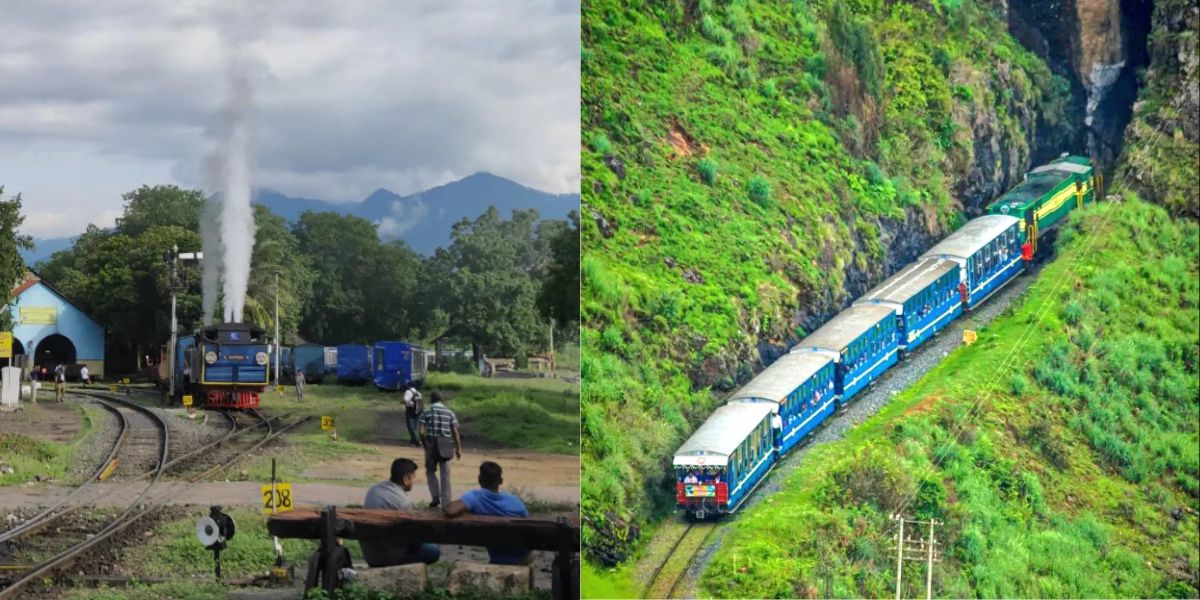
Nilgiri Mountain Railway was built in 1908. (Instagram @NammaMettupalayam/X @Ananth_IRAS)
As the sun’s warmth increases and the yearning for a refreshing escape grows, picture yourself aboard the Nilgiri Mountain Railway (NMR). Constructed by the British in 1908, this single-track railway in Tamil Nadu’s Nilgiris district offers a unique journey from Mettupalayam to Ooty.
It covers 46 km at a leisurely nine km per hour, traverses 16 tunnels, 250 bridges, and 208 steep curves, allowing the passengers to gain a fresh perspective of the Western Ghats mountain range.
In 1854, the British proposed the construction of a mountain railway connecting Mettupalayam to the Nilgiri Hills.
The idea gained momentum, leading to the formation of the Nilgiri Railway Company in 1871. In 1876, Swiss inventor Niklaus Riggenbach offered to undertake the construction of the NMR. The project commenced in August 1891, and by 1898, the section from Mettupalayam to Coonoor was officially opened by the Governor of Madras.
The inaugural journey from Mettupalayam to Coonoor took place in 1899. The NMR’s expansion continued, with services reaching Fernhill in 1907. Eventually, it extended to Ooty in 1908. This marked the completion of the entire NMR stretch, making it fully operational.
Spanning an elevation from 326 meters to 2,203 meters, this railway stood as a symbol of cutting-edge technology during its era. This narrow-gauge railway was designated a UNESCO World Heritage Site in 2005.
The timeless blue and cream colour scheme of the carriages on the NMR ‘Toy Train’ has remained consistent over the years, adding to its charm.
Managed by the Ministry of Railways, with day-to-day maintenance by the Southern Railway, the NMR is the only operational rack railway in India.
Chaiyya Chaiyya from the film Dil Se (1998) stands out as one of the most iconic songs in Indian cinema.
This song was shot on top of the Ooty Toy Train train, powered by the X-Class Steam Locomotive of the NMR.

A still from ‘Chaiyya Chaiyaa’. (Supplied)
The sequence, set against the backdrop of the picturesque Nilgiri Hills, has become etched in the memories of audiences, contributing to the cultural significance of the NMR in Indian cinema.
The first train of the NMR departs from Mettupalayam at 7.10 am, reaching Ooty by 11.55 am. The return journey from Ooty commences around 2 pm and concludes with arrival in Mettupalayam at approximately 5.30 pm. (It’s advisable to confirm these timings before planning your trip, as schedules may be subject to change.)
All set to impress!
Improving the tourist experience, the new Nilgiri Mountain Railway coaches now boast LED lighting, charging points, a public announcement system, and improved suspension and braking systems to enhance comfort while imbibing the scenic views on the go. pic.twitter.com/XqJJ6grX9s
— Ministry of Railways (@RailMinIndia) July 19, 2023
The Nilgiri Mountain Railways is conveniently accessible from various points.
Ooty Bus Stand: Approximately 10 km away, offering a convenient option for bus travellers.
Coimbatore International Airport: Situated around 59 km away, providing easy access for air travellers.
Coimbatore Railway Station: Roughly 60 km away, a feasible option for those arriving by train.
Autos and tourist taxis are readily available and can efficiently transport you to the railway station. Additionally, if you find yourself in Ooty, reaching the station on foot is also a viable option. It will allow you to enjoy the scenic surroundings as you make your way to the NMR station.
You can book first-class compartment tickets for the ‘toy train’ in advance through IRCTC. There are also accessible general compartments. If you choose to purchase tickets on the day of the journey, we recommend arriving at the railway station early.
First Class tickets are priced at ₹600. Second Class tickets at ₹295. To book tickets, visit www.irctc.co.in.
‘Southern Splendours’ is a heritage travel series that serves as your go-to guide for discovering the vibrant religious, historical, and cultural landmarks that dot the scenic landscapes of South India.

Jul 26, 2024

Jul 26, 2024

Jul 24, 2024

Jul 24, 2024

Jul 19, 2024

Jul 18, 2024